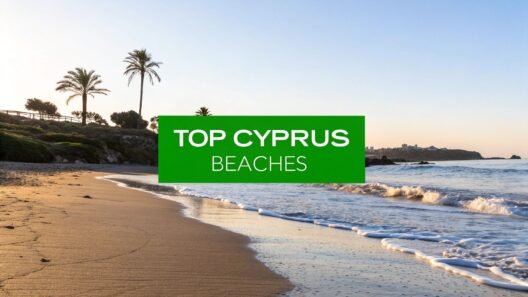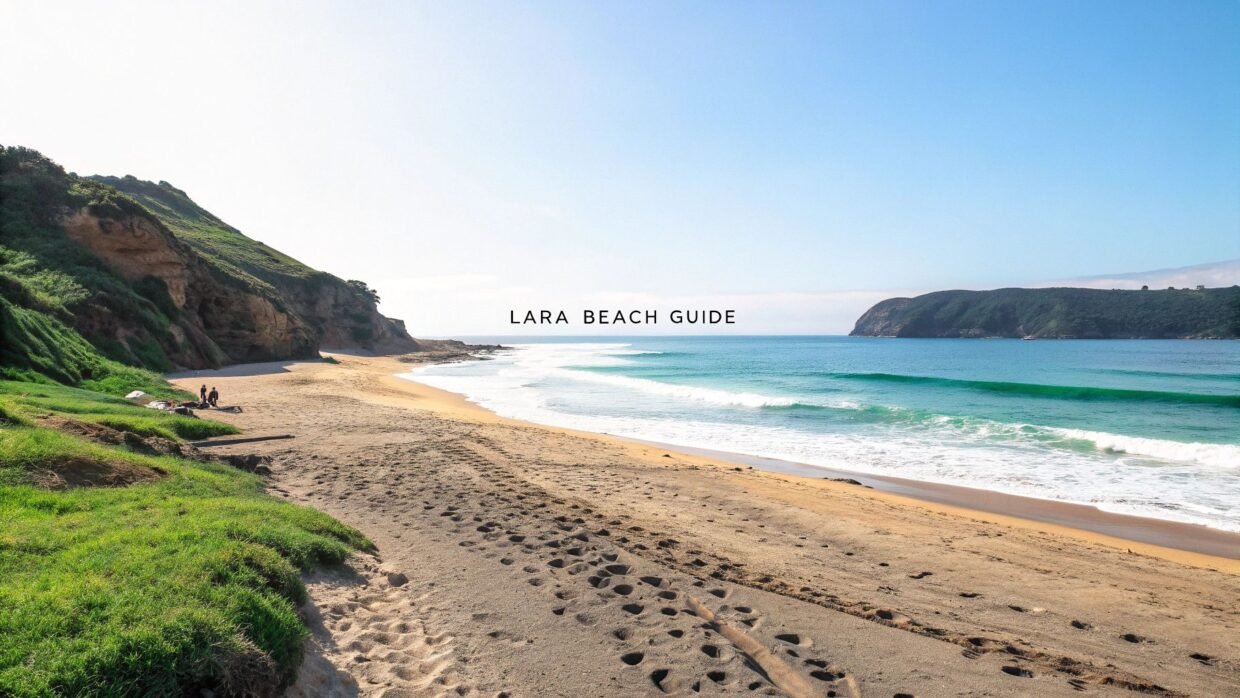If you're looking to escape the crowded, organised beaches of Cyprus, there's a place that feels like a step back in time. Cyprus Lara Beach isn't your typical holiday spot; it's a protected sanctuary of golden sand and turquoise water, a rare glimpse into the island's wild, unspoiled past. Here, nature sets the pace, not tourism.
A Sanctuary Untouched by Time
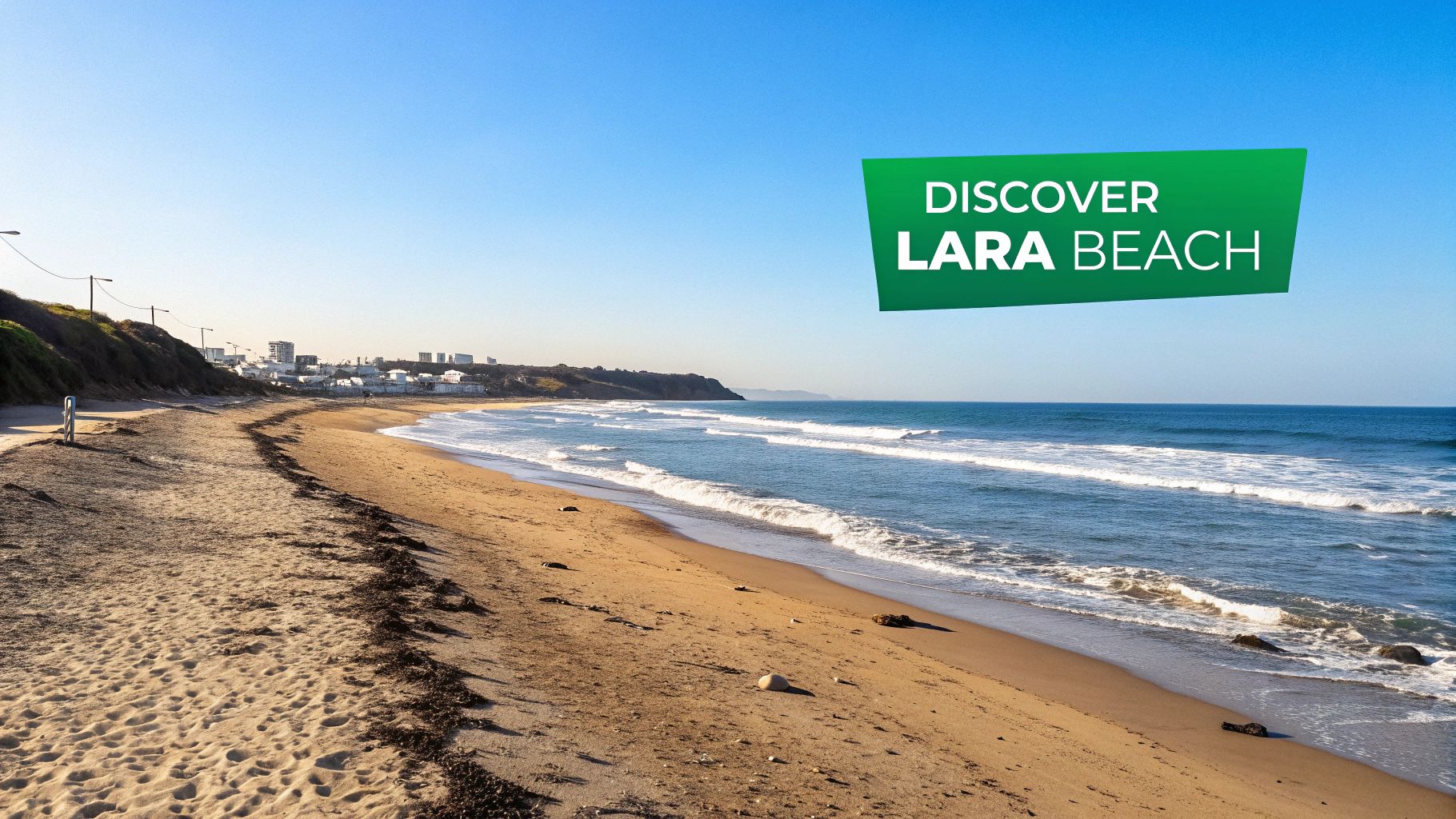
Picture a vast, sweeping bay where the only footprints you see might be your own, or perhaps the tracks of a sea turtle that came ashore the night before. That's the magic of Lara Beach, an ecologically vital stretch of coastline tucked away on the rugged Akamas Peninsula. You won't find rows of sunbeds or buzzing beachfront bars here.
Instead, you get a raw, windswept coastline that has been deliberately left undeveloped. This isn't an oversight; it’s a conscious and crucial effort to protect the beach's most important seasonal visitors.
The Heart of Conservation
Lara Beach's pristine condition is entirely down to its role as a crucial breeding ground for two endangered sea turtle species. In fact, it's one of the most important nesting sites in the entire Mediterranean.
- Green Turtles (Chelonia mydas): Critically endangered in the Med, these turtles rely on Lara Beach as one of their last safe havens for nesting.
- Loggerhead Turtles (Caretta caretta): While more widespread, Loggerheads are also a vulnerable species, and protected beaches like this are vital for their survival.
This conservation focus defines the whole experience. A visit here is less about a standard beach day and more about stepping respectfully into a unique natural habitat. During nesting season, you’ll see protective cages dotted along the sand—a clear sign of the vital work being done to safeguard the next generation of turtles.
A trip to Cyprus Lara Beach offers a genuine connection to nature. It’s a chance to see conservation in action and simply appreciate the quiet, profound beauty of a landscape left to its own devices.
What Makes This Place Special
The real appeal of Lara Beach is its authenticity. It’s a place for those who prefer a bit of adventure over all-inclusive amenities and value solitude over a bustling social scene. The journey to get there, which usually needs a 4×4, naturally filters out the casual crowds, leaving the coastline for those who truly want to experience its wild charm.
The beach itself is made up of two main coves, both offering huge stretches of soft sand and incredibly clear water that’s perfect for a swim or some snorkelling. The surrounding landscape is just as dramatic, adding to the feeling of being somewhere truly remote. To really get a feel for the area, you have to explore the rugged terrain of the Akamas Peninsula is an essential part of the adventure. This guide will set you up for a memorable journey into one of the last true wildernesses in Cyprus.
Your Adventure Guide to Reaching Lara Beach
Getting to Lara Beach is half the adventure. Forget smooth, tarmacked roads; the path to this pristine sanctuary is a rugged, unpaved track that sets it apart from the island's more tourist-friendly shores. It's a journey that demands a bit of respect and the right vehicle.
Think of it less as a simple drive and more as a light off-road expedition. Your standard rental car just isn’t built for this kind of terrain. The bumps and ruts pose a serious risk to the undercarriage and tyres of a normal saloon, and most rental agreements flat-out forbid taking non-4x4s on roads like these. Any damage, and you’ll be footing the bill yourself.
Driving a 4×4 to Lara Beach
For most people wanting a bit of independence, hiring a 4×4 is the way to go. It gives you the freedom to set your own schedule, pulling over whenever you fancy to soak in the incredible coastal views.
The route itself isn't complicated. From the Coral Bay area, you'll head north towards the little fishing harbour of Agios Georgios Pegeias. Soon after, the tarmac disappears, and you're onto the dirt track that snakes along the Akamas Peninsula. From this point, expect the drive to take anywhere from 30 to 45 minutes, depending on how recently the track has been graded and how confident you feel. This isn't a race – slow and steady is the only way to do it.
If you’re planning on driving, it’s a good idea to get your head around the local driving culture. We’ve put together a handy guide with some essential tips for driving in Cyprus that can be a real help, especially when you head off-road.
Thrilling Alternatives for the Journey
If you’d rather let someone else handle the bumpy bits, there are some brilliant alternatives that turn the journey itself into an excursion.
-
Guided Jeep Safaris: This is probably the most hassle-free option. Experienced local guides know these tracks like the back of their hand and will share fascinating stories about the area's history and wildlife. These tours often roll in stops at other cool spots on the Akamas Peninsula, making for a fantastic day out.
-
Quad Bike or Buggy Rental: Fancy a bit more of a thrill? Renting a quad bike or a dune buggy is an exhilarating, wind-in-your-hair experience. You'll feel every part of the track, connecting you directly with the rugged landscape. It offers all the freedom of a 4×4 but with a much bigger shot of adrenaline.
-
Boat Trips: For a completely different perspective of Lara Beach, look into a boat trip from Paphos Harbour or Latchi. You get stunning views of the coastline that you just can't see from the land. Most trips stop for a swim in the crystal-clear waters of the Blue Lagoon before anchoring in the bay near Lara. Just know that boats don't typically pull right up onto the sand, so you'll be admiring the beach from the water.
This visual shows just how much visitor numbers fluctuate with the seasons.
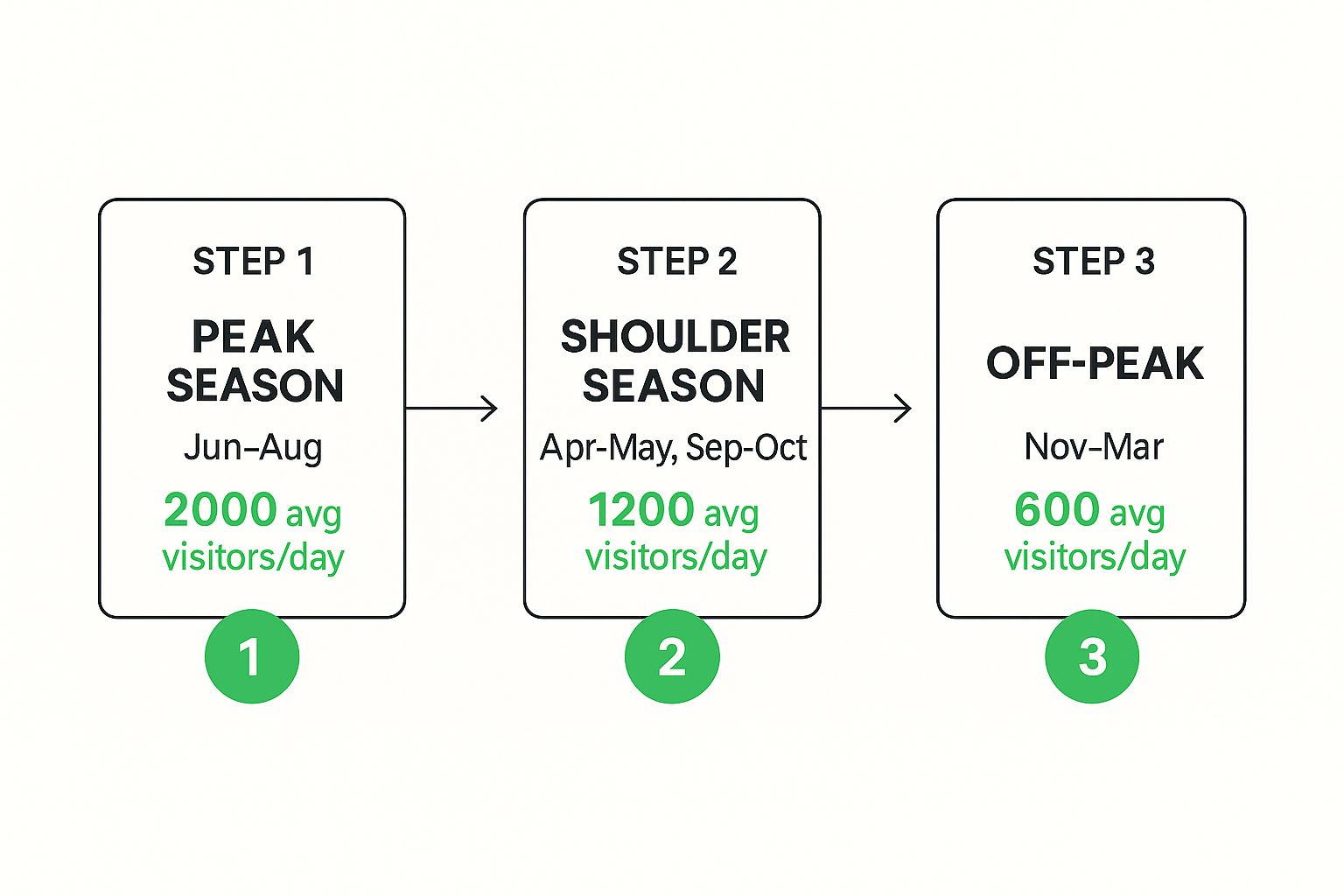
It's clear that even at its absolute busiest, Lara Beach sees only a tiny fraction of the crowds that flock to more developed beaches, which is exactly what keeps its atmosphere so special.
Your final choice really comes down to your budget, your appetite for adventure, and how much comfort you’re after. A 4×4 gives you total flexibility, a Jeep safari offers expert knowledge and ease, a quad bike delivers pure fun, and a boat trip provides unforgettable coastal views.
Whichever way you choose to get there, the reward is the same: an encounter with one of Cyprus's last, truly wild coastal gems.
What to See and Do at This Natural Sanctuary
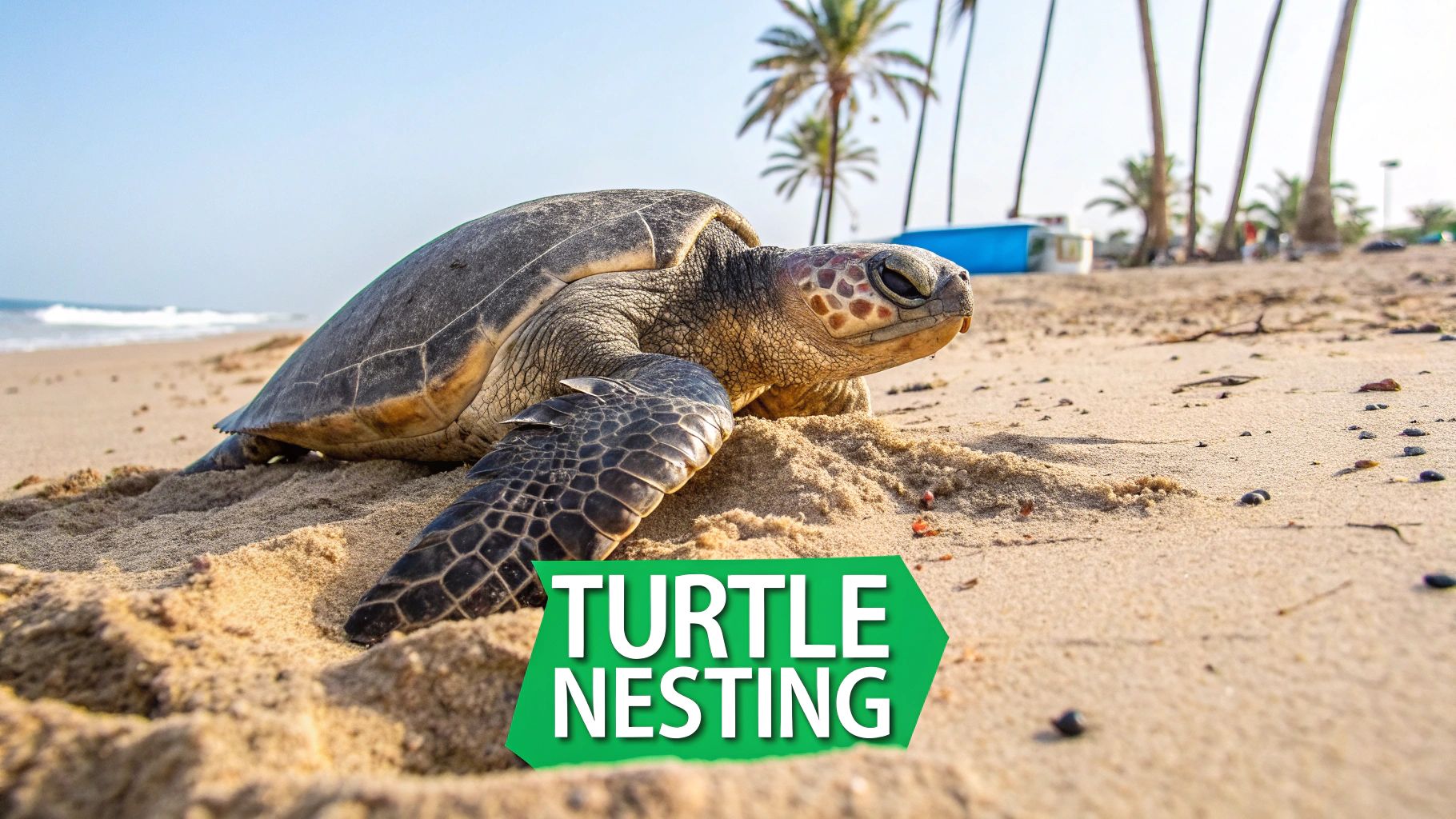
Unlike most coastal spots in Cyprus, Lara Beach isn’t about what you do, but how it makes you feel. The real draw here is nature itself, completely raw and undisturbed. A visit is all about slowing down and appreciating a truly unique ecosystem, with the spotlight firmly on protecting its most famous residents: the sea turtles.
The whole area is a protected nature reserve, and the star of the show is the conservation work happening right in front of you. Forget theme parks; this is a living, breathing sanctuary where you can witness vital preservation efforts firsthand.
The Heart of Lara Turtle Conservation
As you gaze across the vast expanse of sand, the most significant things you’ll spot are the protective metal cages. These simple enclosures mark where turtles have laid their eggs, shielding the nests from being accidentally trampled by visitors or dug up by animals like foxes.
These cages are a powerful visual cue, a constant reminder of why Lara Beach has been left so wild. Each one represents a precious clutch of eggs from either the endangered Green Turtle (Chelonia mydas) or the vulnerable Loggerhead Turtle (Caretta caretta). Simply observing these from a respectful distance is the main event.
A short walk towards the southern end of the beach will bring you to the Lara Bay Turtle Conservation Station. It’s a modest, open-air information point run by dedicated conservationists. They monitor the nests, protect the eggs, and help ensure the tiny hatchlings make it safely to the sea. You’ll often find water tanks here where rescued or weak hatchlings are cared for before they're strong enough to be released.
"Lara Beach is a testament to what can be achieved when nature is prioritised over development. Observing the turtle nests, even from afar, is a profound experience that connects you directly to the delicate cycle of life in the Mediterranean."
The nesting season typically runs from late May to August. Then, from August through to October, the real magic happens as the hatchlings emerge from their sandy nests. If you time your visit right, you’ll gain a deep appreciation for the fragility of this incredible natural process.
Embracing the Natural Playground
Beyond the crucial conservation work, the physical landscape of Cyprus Lara Beach offers a pure, simple kind of fun. The beach is essentially split into two large, crescent-shaped coves, both offering more than enough space to find your own slice of peace and quiet.
Here are the best ways to enjoy this pristine environment:
- Swimming and Snorkelling: The water is exceptionally clear and usually calm, making it a perfect spot for a refreshing dip. The rocky outcrops at the edges of the coves are fantastic for a bit of snorkelling, where you can easily spot a variety of small fish in their natural habitat.
- Walking and Exploring: The sheer size of the beach just begs for long, peaceful walks along the shoreline. With soft golden sand underfoot and the sound of gentle waves, it’s an ideal place to clear your head and just be present in the moment.
- Photography: For photographers, Lara Beach is an absolute dream. The mix of golden sands, turquoise water, rugged headlands, and the dramatic, undeveloped landscape provides endless opportunities for stunning shots, especially during the golden hours of early morning and late afternoon.
This unique, unspoiled character is a massive draw for visitors seeking authentic experiences, especially those from the UK. While Cyprus as a whole achieved a high visitor satisfaction rate of 87.1% in 2022, it's places like Lara Beach that really contribute to this by offering a peaceful alternative to crowded resorts. The sustainable model here, focused on preserving turtle nesting sites, also resonates with the growing demand for eco-conscious travel, a trend detailed in the Cyprus tourism report from the CCCI.
A Different Kind of Beach Day
A trip to Lara Beach requires a bit of a mental shift. This isn't your typical day at the seaside where everything is provided for you. There are no sunbeds, no background music, and no organised entertainment. The 'to-do' list is beautifully simple and dictated entirely by nature.
It’s all about disconnecting from the noise and reconnecting with the environment. It’s about packing a picnic, finding your own private spot on the vast expanse of sand, and soaking in the profound quiet of a place where wildlife, not people, comes first. For more inspiration, you can explore our detailed guide to other key turtle beaches in Cyprus. This back-to-basics approach is precisely what makes a visit here so memorable.
Essential Tips For Your Lara Beach Day Trip
A trip to Lara Beach isn't like your average day at the seaside. You're heading somewhere truly wild, and that's its magic. But its raw, undeveloped beauty means you need to be completely self-sufficient. There are no shops, no cafés, no sunbed rentals, and definitely no toilets.
Think of it less like a beach day and more like a mini-expedition. You need to pack everything you'll need to stay comfortable and safe, and just as importantly, you have to pack everything out again. This isn't just about being tidy; it's about showing respect for one of Cyprus's most precious and fragile ecosystems.
Gearing Up For The Day
To get the most out of your visit to Cyprus Lara Beach, a bit of thoughtful preparation goes a long way. Packing the right gear can turn a potentially tough day into a blissful escape. Forget one of these essentials, and you might find yourself heading back sooner than you'd planned.
Here’s what you absolutely must have with you:
- Water, and Lots of It: The Cypriot sun is no joke, and with zero facilities, dehydration is a serious risk. Always pack more water than you think you'll need—at least a couple of litres per person is a good starting point.
- Food and Snacks: Your only dining option is the one you bring yourself. A well-stocked cool box with a picnic is the way to go. Choose things that won't suffer too much in the heat.
- Your Own Shade: Natural shade is practically non-existent on the beach. A large beach umbrella or a pop-up tent is a lifesaver, especially for escaping the intense midday sun.
- Serious Sun Protection: Don't skimp on the high-SPF sunscreen and reapply it often. A wide-brimmed hat and a good pair of sunglasses are non-negotiable.
- Sturdy Footwear: While flip-flops are fine for the sand, the tracks leading to the beach and the surrounding areas can be rocky. A pair of trainers or walking sandals is a smart choice if you plan on exploring.
- Rubbish Bags: This is the golden rule of Lara Beach: Leave no trace. Every single wrapper, bottle, and scrap of food must come back with you.
Because you have to bring absolutely everything with you, a quick checklist can be a lifesaver.
Your Essential Lara Beach Day Trip Checklist
Here’s a quick summary to ensure your trip is comfortable, safe, and respectful of this incredible natural sanctuary.
| Item/Reminder | Why It's Essential | Pro Tip |
|---|---|---|
| Water & Food | There are zero facilities. No shops, no cafés. You must bring all your own provisions for the entire day. | Freeze a couple of water bottles overnight. They'll act as ice packs and provide cold water later in the day. |
| Shade | The beach offers almost no natural shade. An umbrella or tent is vital for protection from intense sun exposure. | A lightweight pop-up beach tent is often easier to secure in the wind than a traditional umbrella. |
| Sun Protection | Sunscreen (high SPF), hats, and sunglasses are crucial. The sun's reflection off the sand and sea is very strong. | Remember to reapply sunscreen after every swim, even if it's a "water-resistant" formula. |
| Rubbish Bags | Leave no trace. You are responsible for taking all of your rubbish away with you to protect the ecosystem. | Bring an extra bag just in case. It’s a great way to help out if you spot any litter left by others. |
| Appropriate Footwear | While sandy in parts, the access roads and surrounding terrain are rough and rocky. | Wear trainers for the journey there and switch to flip-flops once you're settled on the sand. |
| Respect Nesting Sites | This is a protected area. Keep a safe distance from marked turtle nests and never touch the protective cages. | Explain the importance of the cages to kids so they understand why they need to give them a wide berth. |
Having these essentials sorted means you can relax and truly soak in the unique atmosphere of Lara Beach without any worries.
Respecting The Sanctuary
When you visit, you become a temporary guardian of this incredible turtle habitat. The rules here are simple, but they are absolutely vital for protecting the nesting sea turtles that make this beach so important.
It's a responsibility shared by everyone who visits. In 2024, tourists from the UK made up a massive 34.0% of all arrivals in Cyprus, with nearly a third choosing to stay in the Paphos district. This huge presence highlights just how crucial it is for visitors to practice responsible tourism to protect the very beauty they’ve come to see. If you're interested in the numbers, you can explore the latest tourism statistics for Cyprus.
Always remember, you're a guest in a protected turtle nesting zone. Even the smallest actions can have a huge impact on the survival of these endangered animals.
To be a truly responsible visitor, just stick to these simple guidelines:
- Give the Nests Space: You'll see metal cages marking the nests. Never touch them or disturb the sand around them. Compacting the sand can harm the eggs buried beneath.
- No Visits After Dark: During the nesting and hatching season (roughly May to October), the beach is off-limits after sunset. Nesting females and tiny hatchlings rely on the darkness to find their way; artificial lights can be disorienting and dangerous for them.
- Fill in Your Holes: If you dig a hole or build a big sandcastle, make sure you flatten it completely before you leave. These can become deadly traps for hatchlings making their desperate dash to the sea.
- No Fires or BBQs: Open fires are strictly forbidden. They pose a risk to the delicate coastal vegetation and the local wildlife.
Follow this advice, and your day at Lara Beach will be more than just memorable—it will be a positive contribution to the future of this Cypriot treasure.
Where to Eat and Stay Near Lara Beach
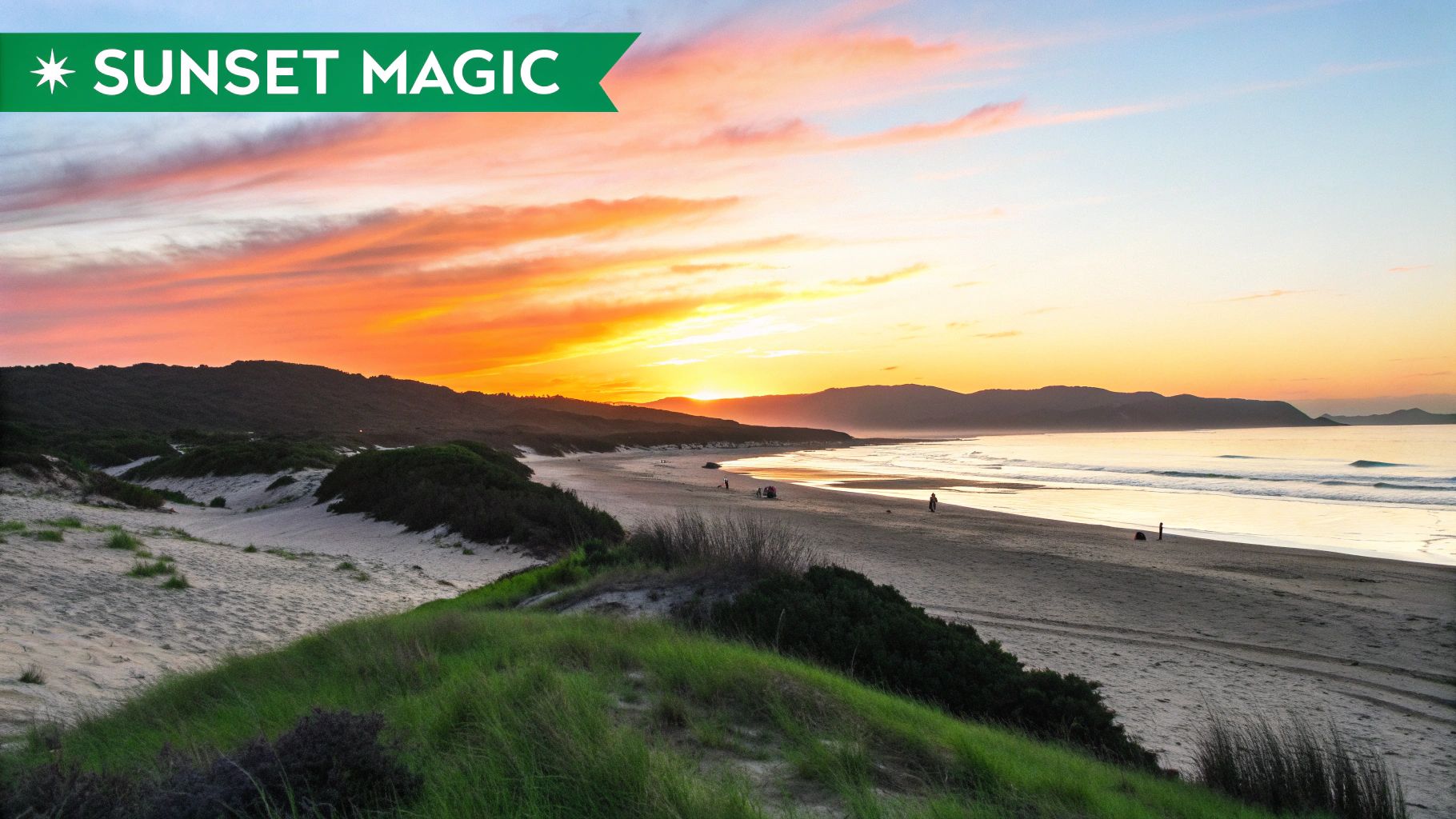
After a day spent marvelling at the raw, windswept beauty of Lara Beach, you’ll be more than ready for some well-deserved comfort and a fantastic meal. The very thing that makes Lara so special—its complete lack of development—means you’ll need to look slightly further afield for your evening relaxation.
Fortunately, the surrounding area is full of charming spots that perfectly bridge the gap between rugged adventure and cosy hospitality. Just remember, the only dining you'll find at the beach is whatever you’ve packed yourself. While a picnic is a great idea for lunch, for a proper post-adventure feast, you’ll need to head back towards civilisation.
Finding the Right Base for Your Akamas Adventure
Your choice of where to stay can really shape your trip, whether you’re after total serenity or a bit more of a buzz. The nearby settlements offer a great launchpad for exploring the whole Akamas Peninsula.
- Agios Georgios Pegeias: This small, tranquil fishing harbour is the closest hub to Lara. It’s the perfect choice if you’re looking for peace and quiet. You’ll find a lovely selection of private villas and holiday apartments here, most with stunning sea views and a genuinely relaxed pace of life.
- Coral Bay: A little further south, Coral Bay is a much livelier resort town. It’s packed with a wide range of hotels, bustling restaurants, and bars, making it a brilliant option if you want plenty of amenities and entertainment on your doorstep.
- Peyia: Nestled in the hills just above Coral Bay, the village of Peyia offers a more traditional Cypriot atmosphere. It boasts some incredible panoramic views and is home to lots of self-catering villas and apartments—ideal for families or groups wanting a bit more space.
Authentic Dining After a Day in the Wild
Nothing rounds off a day of exploring like a hearty, traditional Cypriot meal. The villages around Lara Beach are dotted with family-run tavernas where you can expect authentic flavours and the warmest of welcomes.
The best food near Lara Beach is found in the local tavernas. This is where you’ll find seafood caught that very morning and classic Cypriot dishes made from recipes passed down through generations. It’s a true taste of the island.
Ask for recommendations in places like Agios Georgios, the village of Kathikas, or the outskirts of Peyia. These places pride themselves on serving fresh, seasonal food, from perfectly grilled halloumi and souvlaki to the catch of the day, often served with just a simple drizzle of local olive oil and lemon. It's the perfect reward after your off-road adventure.
Choosing to eat and stay in these local spots does more than just give you an authentic experience. The economic boost from tourism is vital for sustaining these communities and, indirectly, the conservation efforts at Lara Beach. Tourism revenue in Cyprus surged by 53.1% in early 2025, with visitors from the UK making up a significant 16.7% of arrivals.
When you spend your money in these nearby towns, you're helping to fund the very infrastructure that makes visiting protected natural sites like Lara possible. You can read more about the Cyprus economy from recent reports to see just how much of a difference it makes.
Your Questions About Lara Beach Answered
Heading out to a place as wild and wonderfully remote as Lara Beach always brings up a few questions. It's not your typical Cypriot seaside spot with rows of sunbeds and cafes, so knowing what to expect is crucial for a great day out. I've gathered the most common queries right here to help you plan your trip.
When Is The Best Time to Go?
The sweet spot for visiting is definitely between late May and September. By then, the Mediterranean has had a chance to warm up, making the water perfect for a swim. More importantly, this window lines up perfectly with the sea turtle nesting and hatching seasons.
If you're hoping to catch a glimpse of baby turtles making their incredible journey to the sea (from a safe and respectful distance, of course!), your best bet is to plan your visit for August or September.
Can I Get There in a Normal Car?
I really wouldn't recommend it. In fact, it's strongly advised not to try reaching the beach in a standard rental car. The road leading there is a bumpy, unpaved dirt track that can do some serious damage to a normal car’s undercarriage and tyres.
Your only safe options are a proper 4×4 vehicle, a quad bike, or hopping on one of the many guided Jeep safaris that head out that way. Trust me, it's not worth risking your rental deposit or your safety.
The tricky journey to Lara Beach is part of its magic. It's what keeps the crowds at bay and protects its beautifully raw and untouched nature for both the wildlife and the visitors who make the effort.
Are There Any Facilities on the Beach?
Nope, absolutely none. And that's entirely on purpose to protect the fragile ecosystem. You won't find any of the usual beachside comforts here. That means:
- No toilets or changing rooms
- No sunbeds or umbrellas to hire
- No cafes, shops, or restaurants
You need to be completely self-sufficient for the day. Pack plenty of food, water, and something for shade. And the golden rule: whatever you bring with you, make sure you take every last bit of it home again.
Is the Water Safe for Swimming?
Yes, the water at Lara Beach is generally lovely and calm, making it a fantastic spot for a swim. The two big, sheltered bays keep the sea pretty placid.
The only thing to keep in mind is that there are no lifeguards on duty. It’s all about using your common sense – be aware of your surroundings and it's always best not to swim completely on your own.
For more insider tips and detailed guides to help you explore every corner of the island, visit SayCyprus and start planning your perfect Cypriot adventure at https://www.saycyprus.com.








